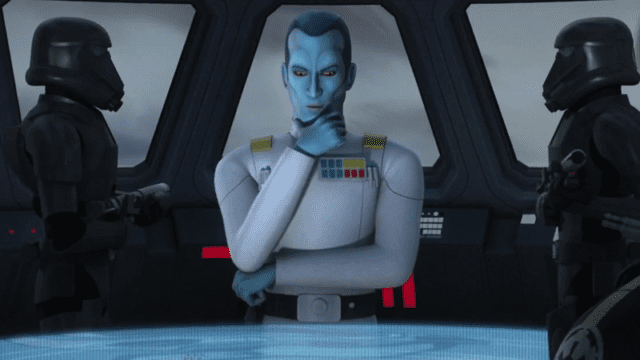
Star Wars is full of cool bullshit which is, in many ways, why we love such an absurd behemoth in the first place. Space wizards with laser swords? Extremely bullshit, and very cool (some of the time). Blaster pistols? They go pew pew, what’s not to love. Starfighters? They go pew pew and fly in space, what’s not to love!? Anyway, screw all of them. The coolest Star Wars bullshit is xenolinguistics.
Specifically, Chiss xenolinguistics. While readers of io9 know I’m more than willing to discuss Star Wars nonsense at the drop of a hat, this particular indulgence was brought about by Del Rey’s recent tease for its next Star Wars novel, Thrawn Ascendancy: Chaos Rising—the first in a new trilogy from legendary Star Wars author Timothy Zahn. Unlike his recent books about the steely master tactician, the Ascendancy trilogy is not about Thrawn’s time in the Empire, but the time he still lived with his people, the Chiss, in the Unknown Regions. Which means the cast list for the book… requires some explanation:
We know Thrawn as Thrawn (his “Core name”) simply because it’s the name he and other Chiss use in less formal situations. He also uses it when he eventually makes his way into the part of the Star Wars galaxy as we know it, because speakers of Basic—space-English, basically—find full Chiss names hard to pronounce. Thrawn’s full name is Mitth’raw’nurodo, and aside from being incredibly Star Wars simply just from looking at it, it’s also incredibly Star Wars because there’s a reason it looks like the sound you might make stepping on a Lego brick or something.
Chiss society—the titular Ascendancy, based on the planet Csilla—puts huge importance on names because they not only reflect a being, but their family, and their role within that family. Csilla is governed by nine major clans, which form the first fragment of a Chiss name. The other parts are a mix of a personal name, as well as an indicator of that person’s position in a family on an administrative and hierarchical level, and even whether or not they are part of that family by blood or by adoption. Take our friend Mitth’raw’nurodo—the “Mitth” is Thrawn’s family, almost a surname to us. “Raw” is his given name, and then “nuruodo” reflects his relationship to his family. In this case, Thrawn is a merit adoptive of the Mitth family: he wasn’t born into it by blood, but is in the process of trying to join it permanently by serving in the Chiss military.
G/O Media may get a commission
Confusing? Yes. Geeky? As all hell. But also absolutely fascinating? Definitely.
Much of these conventions are a holdover from what Zahn established about the Ascendancy in his pre-Disney Star Wars work. The current canon has re-acquired so much of what came before it in the past few years, and the author has definitely played a large part in that with his return to his most famous character, making the transition for fans much smoother. For newcomers who met Thrawn through Rebels, there’s this whole weird new culture to explore, all these hierarchies and class systems. For fans who’ve loved Thrawn since Heir to the Empire, it’s like returning to an old friend and approximately three billion contractions (suffice to say: you’ll get used to it). But even then, it’s still so cool to dive into all these ways the Chiss’ preponderance for family and social status is so deeply imbued into the Ascendancy’s culture that it forms the very definition of a being’s name. It makes it all the more interesting to see how individual Chiss choose to bend and shape those conventions to find ways to define themselves outside of it.
The Chiss aren’t the only Star Wars aliens we have this sort of geeky detailing for, of course. Karen Traviss’ Republic Commando series did so much for fleshing out Mando’a, the language of the Mandalorians, for example, that we still see echoes of it in Star Wars fiction today. Thanks to the wonderful world of the Star Wars roleplaying games, we have information about naming cultures and conventions for more background alien species than you could shake a lekku at. (Speaking of: did you know in the old EU, Twi’leks had a true name that blends their personal and clan names into a single word with its own meaning in Ryl, and one they use for non-Twi’leks that separates their two names into a different meaning? Cool!)
Yet Zahn’s work on the Chiss, and the way they talk with and about each other, still remains some of Star Wars’ most fascinating explorations of alien culture—it makes them feel truly alien, to both the audience and the denizens of the galaxy far, far away. Their status as this outsider race from beyond what our usual Star Wars characters know of the galaxy is matched only by how differently their culture is presented to us compared to other Star Wars beings. For better or worse, most Star Wars aliens are defined as being different mostly because they don’t look human (or if they do, they’re humanish, and one of a rainbow of skin tones).
The Chiss stand out because, while they are that on the surface—they’re the Blue Man Group of the unknown regions!—their tone and language, and the way that is presented to the beings around them, is unlike anything else we typically see in the franchise. They have this culture that is their own, for use among themselves, and have to bend to the conventions we would typically expect of a Star Wars race when outside of it. This new series of novels, taking place primarily within the Chiss Ascendancy, is our first real chance in the current canon to explore what being inside that society was really like.
To be sure, we know way, way more than we feasibly should about a lot of Star Wars races because, once again, this franchise is always some of the dorkiest stuff around thanks to its scope and breadth over the past 40-plus years. But even then, Zahn—and other writers who’ve tackled the Chiss since his game-changing creation of Thrawn all those years ago—created some of the most fascinating aspects of the old Expanded Universe. With Thrawn’s return to canon in the last few years thanks to Rebels and these new novels, we’re glad it’s continuing to be explored once more.
For more, make sure you’re following us on our Instagram @io9dotcom.
Source: gizmodo.com








